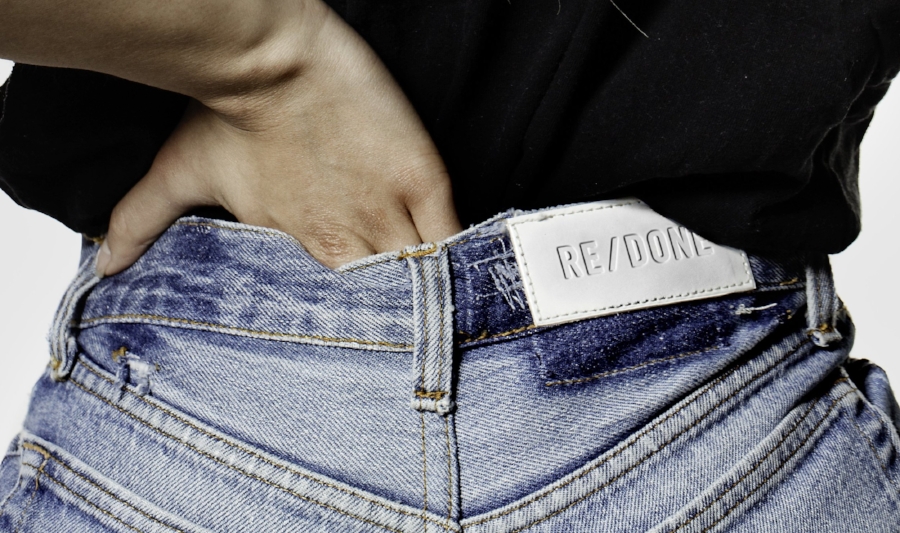 image: RE/DONE
image: RE/DONE
A lot of designations are tossed around in connection with millennials. In addition to being hailed as the first generation to be highly immersed in a digital landscape in their early years, millennials – individuals born between the early 1980’s and 2000 – are largely viewed to be more tapped into social causes and participating in activism than many of the generations before them, and if analysts are to be believed, they have discretionary income to back up those social beliefs.
Part of the narrative associated with this intriguing generation of individuals is their interest in sustainability. As Nielsen reported a few years ago, “Despite the fact that Millennials are coming of age in one of the most difficult economic climates in the past 100 years, they continue to be most willing to pay extra for sustainable offerings.” Early this year, sustainability-focused consultancy Shelton Group found that found 90 percent of millennials are more likely to buy from a brand whose social and environmental practices they trust.
This widely reported sentiment has one glitch: Consumption of fast, cheap, disposable fashion continues to grow. Yes, despite widespread interest amongst consumers of millennial ilk to shop in ways that do not support the harms associated with the practice of fast fashion – both in terms of environmental sustainability and human rights – the intense demand for trendy, inexpensive clothing is not waning.
One of Britain’s biggest discount-clothing chains, ASOS, for instance – which sells dresses starting at $12 and denim for as little as $20 – announced this month that its revenue for 2018 is up by 28 percent and the number of visits to its e-commerce site exceeded 1 billion for the first time. Compared to this time last year, customers placed 28 percent more orders with the fast fashion giant, which is seeking to take the title of “the world’s number one destination for fashion loving 20-somethings.”
Boohoo, another British fast fashion company, announced this week that it beat forecasts with a 40 percent rise in 2017-18 profit driven by a jump in revenue on rising e-commerce demand.
Meanwhile, Los Angeles-based brand Fashion Nova and a whole slew of light-speed fashion retailers, one that make H&M and Zara’s models look dated and slow, are dominating the market with their expanses of dirt-cheap offerings, including those endorsed by some of the most influential Instagram figures of the moment.
How does one reconcile this growth with claims that millennial consumers are interested in sustainability? Here’s one way: Sustainably-made clothing is expensive, oftentimes much more expensive than the $40 jeans at Zara. A floor-legth dress from H&M’s Conscious Collection will set you back $150, whereas one from its main collection will cost $60 or less.
The prices of garments and accessories that come from carefully managed supply chains simply cost more than those that come from fast fashion brands (and no shortage of other mass market brands), thereby largely removing the ability of many consumers to buy garments and accessories on a whim to wear once or two and then guiltless-ly discard.
The ability of brands to enable consumers to mindlessly pick up a few trend-specific dresses or pairs of jeans and wear them for one season – or on one vacation – is what tends to drive a significant portion of fast fashion sales. These brands and their low prices also fill a void for consumers on a budget but that still want runway-inspired or trend-driven goods.
It is worth noting that sustainably-minded brands, such as Stella McCartney, Reformation and Re/Done, are all successfully pushing the boundaries of what sustainable fashion can/should look like (proving that eco-fashion and high fashion are mutually exclusive and that one does not have to sacrifice trendiness in order to shop sustainably). Yet, this segment of the market will arguably never replace fast fashion as the go-to for consumers as long as prices remain as high as they are.
In short: While millennials very well may be extremely taken with the idea of shopping sustainably, price remains the road block for many, and until brands either find ways to make eco-friendly wares more affordable (potentially by way of direct-to-consumer models, such as Evelane) until millennials have more discretionary income or until a larger cultural shift away from senseless consumption happens, price will be the foremost concern for most consumers.











